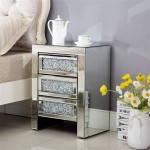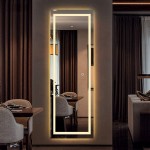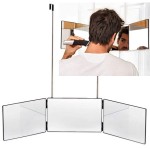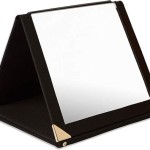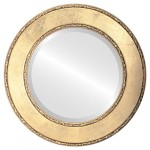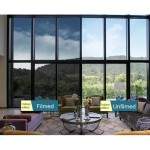Art Deco Mirror Picture Frames: A Reflection of Elegance
Art Deco, a design movement flourishing in the 1920s and 1930s, left an indelible mark on architecture, interior design, fashion, and art. Characterized by its geometric shapes, bold colors (often juxtaposed), and luxurious materials, Art Deco sought to embody modernity and progress. The movement rejected the flowing naturalism of Art Nouveau and embraced the machine age, drawing inspiration from sources as diverse as ancient Egypt, Aztec art, and Cubism. Among the many decorative objects produced during this period, the Art Deco mirror picture frame stands out as a particularly elegant and functional piece, reflecting both aesthetic innovation and the era's fascination with glamour.
These frames often transcended mere functionality, becoming artworks in their own right. They were not simply containers for photographs or artwork; they were statements of style, reflecting the affluence and sophisticated taste of their owners. The materials used, the craftsmanship involved, and the overall design contributed to a sense of luxury and exclusivity. Finding a period example is a unique opportunity to add a touch of glamour to any home.
Key Characteristics of Art Deco Mirror Picture Frames
Several defining features distinguish Art Deco mirror picture frames from those of other eras. These characteristics not only contribute to their aesthetic appeal but also provide insights into the design principles and cultural values of the Art Deco period. Examining these key features is essential for understanding the enduring appeal of these decorative objects.
Geometric Shapes and Symmetry: One of the most recognizable features of Art Deco design is its emphasis on geometric shapes. Mirror picture frames from this era frequently incorporate squares, rectangles, triangles, chevrons, and stepped patterns. These shapes are often arranged in symmetrical compositions, creating a sense of balance and order. The symmetry is not always perfect; there may be slight variations to add visual interest, but the overall impression is one of structured elegance. The use of geometric motifs reflects the Art Deco movement's embrace of the machine age and its rejection of organic, flowing forms.
Materials: Art Deco mirror picture frames were typically crafted from high-quality materials, often combining different elements to create a luxurious and visually striking effect. Common materials include:
- Mirrored Glass: Naturally, mirrored glass is a primary component, often used not only for the central reflective surface but also as decorative accents on the frame itself. Beveled edges were common, adding depth and sparkle.
- Bakelite and Catalin: These early plastics were popular for their vibrant colors and ability to be molded into intricate shapes. Art Deco frames often feature Bakelite or Catalin accents in contrasting hues, such as black, red, or green.
- Chrome and Other Metals: Chrome plating was a hallmark of Art Deco design, providing a sleek, shiny surface. Other metals, such as nickel and brass, were also used, often in combination with mirrored glass and plastic components.
- Wood: While less common than metal or plastic, wood was sometimes used as a base for Art Deco frames, often lacquered or veneered to create a smooth, glossy finish.
Color Palette: The color palette of Art Deco mirror picture frames is diverse, ranging from bold and vibrant hues to more subdued and sophisticated tones. Common color combinations include black and gold, silver and black, emerald green and chrome, and various shades of pastel. High contrast combinations were particularly popular, creating a dynamic and eye-catching effect. The use of metallic accents, such as gold and silver leaf, added a touch of glamour and opulence. The colors reflect the era's sense of optimism and its embrace of modernity.
Design Motifs and Decorative Elements
Beyond the use of geometric shapes and specific materials, Art Deco mirror picture frames often incorporate distinctive design motifs that contribute to their overall aesthetic appeal. These motifs draw inspiration from a variety of sources, reflecting the eclectic nature of the Art Deco movement. Recognizing these motifs can aid in identifying and appreciating the unique characteristics of these frames.
Stepped Patterns: Stepped patterns, resembling ziggurats or stylized skyscrapers, are a quintessential Art Deco motif. These patterns are often used to create a sense of height and grandeur. In mirror picture frames, stepped patterns might be incorporated into the corners or along the edges, adding depth and visual interest. The stepped design reflects the era's fascination with modern architecture and its aspiration towards progress.
Sunbursts: The sunburst motif, representing radiance and optimism, is another common element in Art Deco design. Sunbursts can be depicted in a variety of ways, from stylized rays emanating from a central point to more abstract geometric interpretations. In mirror picture frames, sunbursts might be used as decorative accents, adding a touch of dynamism and energy. This motif directly reflects the optimism and hope for the future prevalent during the period.
Zigzags and Chevrons: Zigzags and chevrons are geometric patterns that evoke a sense of movement and energy. These patterns are often used in Art Deco mirror picture frames to create a dynamic and visually engaging effect. Zigzags might be incorporated into the overall design of the frame, while chevrons might be used as decorative accents. These patterns contribute to the frame's overall sense of modernity and sophistication.
Stylized Floral and Animal Motifs: While Art Deco largely rejected the naturalistic forms of Art Nouveau, stylized representations of floral and animal motifs were sometimes incorporated into designs. These motifs were typically highly geometric and symmetrical, reflecting the Art Deco aesthetic. Examples include stylized lotus flowers, peacock feathers, and gazelles. The use of these motifs added a touch of elegance and exoticism to the overall design.
The Enduring Appeal of Art Deco Mirror Picture Frames
The enduring appeal of Art Deco mirror picture frames stems from a combination of factors, including their aesthetic beauty, their historical significance, and their versatility as decorative objects. These frames represent a distinctive era in design history and continue to be prized by collectors and enthusiasts alike. Their ability to seamlessly blend functionality with artistic expression contributes to their lasting popularity.
A Timeless Aesthetic: The clean lines, geometric shapes, and luxurious materials of Art Deco design create a timeless aesthetic that remains appealing to contemporary tastes. Art Deco mirror picture frames can complement a variety of interior design styles, from minimalist and modern to more traditional and eclectic. Their ability to add a touch of elegance and sophistication to any space ensures their continued relevance.
Historical Significance: Art Deco mirror picture frames represent a specific period in history, reflecting the cultural values and aesthetic preferences of the 1920s and 1930s. Owning such a frame is a way to connect with the past and to appreciate the artistry and craftsmanship of a bygone era. These frames serve as tangible reminders of a time of great innovation and creativity.
Versatility as Decorative Objects: Art Deco mirror picture frames are not limited to displaying photographs or artwork. They can also be used as decorative accents in their own right. They can be hung on walls, placed on shelves, or used as part of larger decorative arrangements. Their reflective surfaces can add light and depth to a room, enhancing its overall ambiance. This versatility makes them a valuable addition to any interior design scheme.
In addition to these points, the craftsmanship involved in creating Art Deco mirror picture frames is often exceptional. Many frames were handmade, with meticulous attention to detail. The use of high-quality materials ensured their durability and longevity. The combination of skilled craftsmanship and innovative design contributes to the enduring value of these decorative objects. As tangible artifacts of a significant design movement, Art Deco mirror picture frames provide a glimpse into the past while continuing to enhance the present.

Buy Elise Art Deco Frame Wall Mirror At 30 Off Retail Staunton And Henry

Art Deco Mirror Gold Leaf 20329 Mirrors By Image Home Bathroom Decor

Atticus Handcrafted Art Deco Glam Wall Mirror With Black And Silver Frame Bespoke Mirrors Custom Made

Art Deco Design Artisan Needlepoint Framed Large Mirror For At 1stdibs Andre Groult Frame Painted

Art Deco Frame Mirror Print Andrew Lee Home And Living

Art Deco Mirror Wall Decoration Inventory Glantiques

Baxton Studio Art Deco Rectangular Wall Mirror With Metal Frame 44 X 32 Antique Gold Odp Business Solutions

Wall Mirror With Art Deco Style Frame

Art Deco Style Mirror With Clear And Champagne Tinted Mirrored Panels 1970s Lobel Modern Nyc

Art Deco Framed Mirror 30 S Plaster Decorative With Foliage Design Wall Decor

